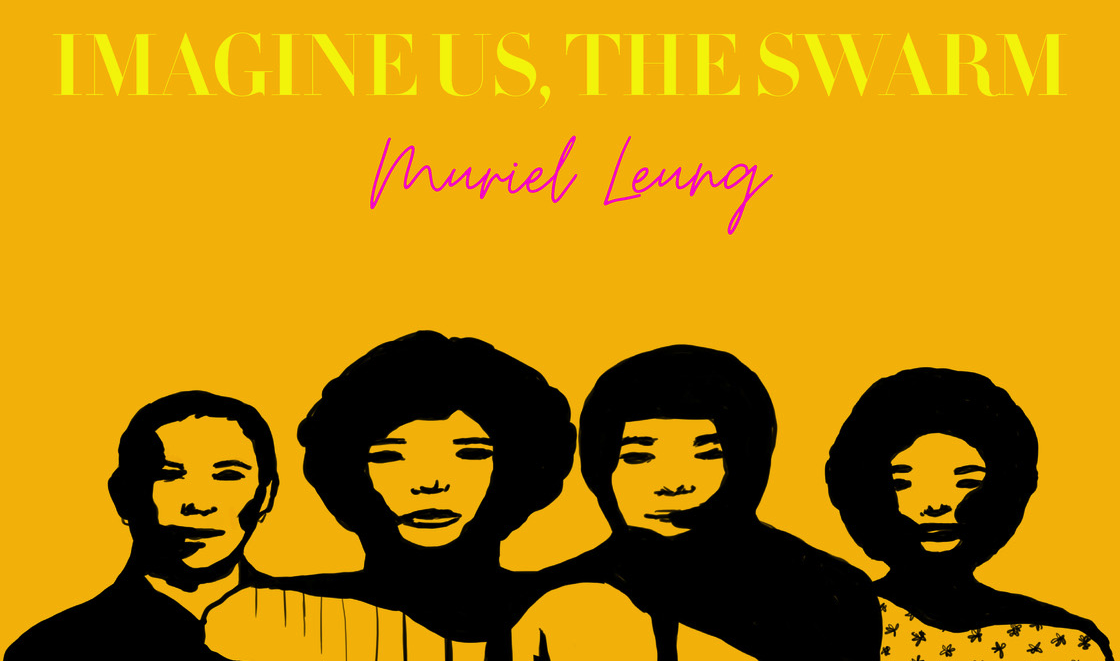
Imagine Us, The Swarm
Muriel Leung
Nightboat Books, 2021
Review by Lou J. Baker
On a page filled almost entirely with lines of ellipses, a single phrase stands alone: “I think it’s funny that the book is not about bees at all.” Muriel Leung’s Imagine Us, The Swarm begins with bees—creatures at once small and huge, as powerful as their swarms, as delicate as their individual bodies (and vise versa).
The collection considers the impact of labour on the body, as well as Leung’s father’s experience with pancreatic cancer, and his eventual passing. These are tightly intertwined; accustomed to pain, Leung’s father initially ignores his symptoms, assuming he has an ulcer. By the time his cancer is discovered, it’s already Stage IV. “He had put it off,” Leung writes in “THE PLURAL CIRCUITS OF TELL,” “thinking it was his body’s knotted revenge for years of abuse.” Leung probes labour on different scales. In “THIS IS TO LIVE SEVERAL LIVES” she writes, “The story of labor is that it goes on. / The hive hums its vacant sound.” Later, she asks, ““Is it work if it doesn’t hurt? If you like it?” / “Are you allowed to like it? The work?” / “If it hurts and you are not sure if you like it, is that also work?”.”
Using scientific language as a doorway onto the experience of immigration, “THE PLURAL CIRCUITS OF TELL” features in-depth footnotes linking research to elements of Leung’s family’s experience. “In this inheritance,” Leung writes, “a sign hangs over everything: YOU TOO CAN MAKE IT IF YOU TRY.” At the end of this line is a footnote—our eyes are drawn to the bottom of the page to read:
…In metaplasia, the cell changes its internal properties to adapt to its new environment. But adaptation should not be confused with assimilation. The former transforms to bear the stresses of its surroundings. The latter attempts to perform in the likeness of its external environment’s demands.
Imagine Us, The Swarm deals with generational trauma and violence, weaving together the threads that join generations of women in Leung’s family with queer theory and cinema. “I MARVEL AT THE NOISES A MORE PERFECT VENGEANCE MAKES,” and ekphrastic piece that engages with Park Chan-wook’s 2005 film Lady Vengeance, explores vengeance and justice through the film’s protagonist Geum-Ja. In this piece we see another expression of the swarm, as family members of murdered children gather to “exact vengeance” on their children’s killer—“the families rage on, a deep red pummeling. A pool of him / in a plastic sheet, / swimming in a non-apology.”
The piece is a reclamation of power against an abuser, vengeance extending across generations of wrongs unpunished. “I dream my ancestors alive, willing them to the table,” writes Leung. “How the thread of harm extends both ways.” The experience of the femme body and the violence enacted against it, the “violence of men / and the colonial rituals of their pasts,” is an unending cycle, disrupted in “I MARVEL AT THE NOISES” by a vengeful ghost. Later, Leung writes:
The atomic weight of him pressed so deep into my torso
that generations after would feel the soreness of ribs.
Suppose my grandfather never struck my aunt
because her cheek was there…
(“WHEN I IMAGINE ALL THE POSSIBILITIES OF THE SWARM”)
Queerness, in this poem, causes a disruption, a fluctuation in the pattern of trauma—knowledge from a future self passed backwards. “Suppose I became the sound of windchimes / crashing into the ground,” Leung writes. “We can dress ourselves in the celestial cloak / of this wide expanse, every woman and femme…All the possibilities of the swarm ignite.”
Leung makes expert use of form to create a collage of thought in these essays in verse—blending prose poetry, footnotes, and the use of blank space and periods on the page. At times Leung uses dotted lines as a form of concrete poetry, ideas of separation and fragmentation made physical:
the migration as a broken history
………………………………………………………………………………………………………
………………………………………………………………………………………………………
we don’t talk about
(“THIS IS TO LIVE SEVERAL LIVES”)
At another point, Leung draws our attention to the ideas of empty space and missing information—to embracing and incorporating the net-like nature of memory.
I……
suppose this is………
……a way……………
……to remember……
………with holes..…
With a skilled hand, Leung crafts exquisite hybrid shapes—beautiful balancing acts of language and form. At the start of this collection, Leung states: “To write a book is to write into a future and I am not ready.” Imagine Us, The Swarm writes fearlessly and honestly, calling a new future into existence with every word.
Lou J. Baker‘s work can be found in the Edinburgh University Press. A genderqueer visual artist and lover of poetry, they are completing an MA in Contemporary Art Practice, and spend the rest of their time with their dog, Milo.